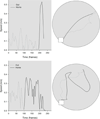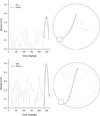Otolithic information is required for homing in the mouse
- PMID: 25565056
- PMCID: PMC4492892
- DOI: 10.1002/hipo.22410
Otolithic information is required for homing in the mouse
Abstract
Navigation and the underlying brain signals are influenced by various allothetic and idiothetic cues, depending on environmental conditions and task demands. Visual landmarks typically control navigation in familiar environments but, in the absence of landmarks, self-movement cues are able to guide navigation relatively accurately. These self-movement cues include signals from the vestibular system, and may originate in the semicircular canals or otolith organs. Here, we tested the otolithic contribution to navigation on a food-hoarding task in darkness and in light. The dark test prevented the use of visual cues and thus favored the use of self-movement information, whereas the light test allowed the use of both visual and non-visual cues. In darkness, tilted mice made shorter-duration stops during the outward journey, and made more circuitous homeward journeys than control mice; heading error, trip duration, and peak error were greater for tilted mice than for controls. In light, tilted mice also showed more circuitous homeward trips, but appeared to correct for errors during the journey; heading error, trip duration, and peak error were similar between groups. These results suggest that signals from the otolith organs are necessary for accurate homing performance in mice, with the greatest contribution in non-visual environments.
Keywords: head direction; navigation; path integration; self-movement; vestibular.
© 2015 Wiley Periodicals, Inc.
Figures






References
-
- Alyan SH, Jander R. Interplay of directional navigation mechanisms as a function of near-goal distance: experiments with the house mouse. Behav Processes. 1997;41(3):245–255. - PubMed
-
- Avni R, Elkan T, Dror AA, Shefer S, Eilam D, Avraham KB, Mintz M. Mice with vestibular deficiency display hyperactivity, disorientation, and signs of anxiety. Behav Brain Res. 2009;202(2):210–217. - PubMed
-
- Benhamou S, Sauve J-P, Bovet P. Spatial memory in large scale movements: Efficiency and limitation of the egocentric coding process. J Theor Biol. 1990;145:1–12.
-
- Besnard S, Machado ML, Vignaux G, Boulouard M, Coquerel A, Bouet V, Freret T, Denise P, Lelong-Boulouard V. Influence of vestibular input on spatial and nonspatial memory and on hippocampal NMDA receptors. Hippocampus. 2012;22(4):814–826. - PubMed
-
- Cahill SP, Fifield KE, Thorpe CM, Martin GM, Skinner DM. Mice use start point orientation to solve spatial problems in a water T-maze. Anim Cogn. 2014 - PubMed
MeSH terms
Grants and funding
LinkOut - more resources
Full Text Sources
Other Literature Sources

